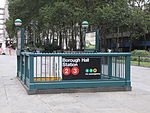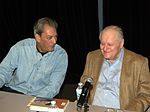Thomas Jefferson Association Building
Brooklyn HeightsCommercial buildings in BrooklynDemocratic Party (United States) organizationsDemolished buildings and structures in BrooklynFrank Freeman buildings ... and 5 more
New York State Democratic CommitteeOffice buildings completed in 1890Office buildings in New York CityRichardsonian Romanesque architecture in New York CityUse mdy dates from October 2019

The Thomas Jefferson Association Building was a building located in Brooklyn Heights, Brooklyn, New York. Designed by Brooklyn-based architect Frank Freeman and completed in 1890, it was considered a fine example of the Richardsonian Romanesque style. The building was demolished to make way for a new thoroughfare in 1960.
Excerpt from the Wikipedia article Thomas Jefferson Association Building (License: CC BY-SA 3.0, Authors, Images).Thomas Jefferson Association Building
Court Street, New York Brooklyn
Geographical coordinates (GPS) Address Nearby Places Show on map
Geographical coordinates (GPS)
| Latitude | Longitude |
|---|---|
| N 40.693702 ° | E -73.990383 ° |
Address
Cadman Plaza West & Montague Street
Court Street
11231 New York, Brooklyn
New York, United States
Open on Google Maps









